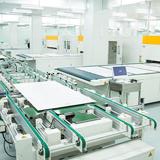

Paste plate, also known as blockage, refers to the phenomenon that the through-hole portion of the screen printing plate cannot transfer ink to the substrate during printing. The appearance of this phenomenon will affect the quality of printing, and even in normal cases, normal printing will not be possible.
The reasons for the paste phenomenon generated during the screen printing process are intricate. The reason for the paste can be analyzed from the following aspects.
1 The reason for the substrate. Screen printing substrates are varied, and the texture characteristics of the substrates are also a factor in the paste-forming phenomenon. For example: paper, wood. Fabrics and other substrates have low surface smoothness and poor surface strength. In the printing process, it is easy to produce powder and hair loss, thus causing paste.
2 The reason for the temperature, humidity and ink properties of the workshop is that the screen printing workshop requires a certain temperature and relative humidity. If the temperature is high and the relative humidity is low, the volatile solvent in the ink will quickly evaporate, and the viscosity of the ink becomes high, thereby blocking the mesh. Another point to note is that if the downtime is too long, a paste phenomenon will occur, and the longer the paste, the more serious the paste. Secondly, if the ambient temperature is low, the ink flowability is poor and the paste is easily generated.
3 reasons for screen printing. The prepared screen printing plate can be used after being rinsed with water and dried before use. If it is placed in the plate for a long time and is not printed in time, the dust will adhere to it more or less during the preservation process. If it is not cleaned during printing, it will cause a paste.
4 reasons for printing pressure. Excessive embossing force during printing will cause the squeegee to bend. The squeegee is not in line contact with the screen printing plate and the substrate, but is in surface contact, so that the ink cannot be scraped clean every time the squeegee is left, leaving a residue. Ink, after a certain period of time, the conjunctiva will cause a paste.
5 The reason for the improper gap between the screen printing plate and the substrate. The gap between the screen printing plate and the substrate should not be too small, the gap is too small. After the squeegee printing, the screen printing plate cannot be separated from the substrate. When the screen printing plate is lifted, a certain ink adheres to the bottom of the printing plate, which is also easy. Cause a paste.
6 reasons for the ink. When the particles of the pigment and other solid materials in the screen printing ink are large, the phenomenon of blocking the mesh is apt to occur. In addition, the mesh size and the through-hole area of the selected mesh are smaller than the particle size of the ink, so that the coarser-grained ink is less likely to pass through the mesh and the net sealing phenomenon is also the cause.
One. The paste caused by the large particles of the ink can be solved from the time of manufacturing the ink, and the main method is to strictly control the fineness of the ink.
The ink dries too fast during the printing process, which easily causes the paste to malfunction. This phenomenon is particularly prominent when using a volatile dry type ink, so it is necessary to select an appropriate solvent to control the drying speed during printing. When selecting inks, the effects of climate should be considered. Generally, fast-drying inks should be used in winter. In summer, dry-drying agents should be added to the inks. If paste-forming is used in the case of late-drying agents, other types of inks must be used.
With oxidative drying inks, the paste phenomenon does not appear much, but if the desiccant is used excessively in the summer, the paste phenomenon will occur, and the desiccant is generally controlled in summer.
When the two-liquid reaction type ink is used, since the drying speed of the ink itself is slow, the paste phenomenon hardly occurs, but occasionally the paste phenomenon occurs.
In the printing process, the viscosity of the ink is increased to cause the paste. The main reason is that the solvent of the ink on the plate evaporates, causing the viscosity of the ink to increase, and the phenomenon of sealing the net occurs. If the printed graphic area is relatively large, the ink on the screen printing plate consumes a lot, and the paste phenomenon is less. If the image area is small and the ink consumption on the screen printing plate is small, it is easy to cause a paste, and the countermeasures are often replaced with new ink. The poor fluidity of the ink causes the ink to form a paste when it is not passed through the screen. This can be solved by reducing the viscosity of the ink to improve the fluidity of the ink.
Tel:15158365810
HTML:www.mysyqc.com
Add:No.185, bridge 3 road, xiaoqiaotou village, qiaotou town, cixi city